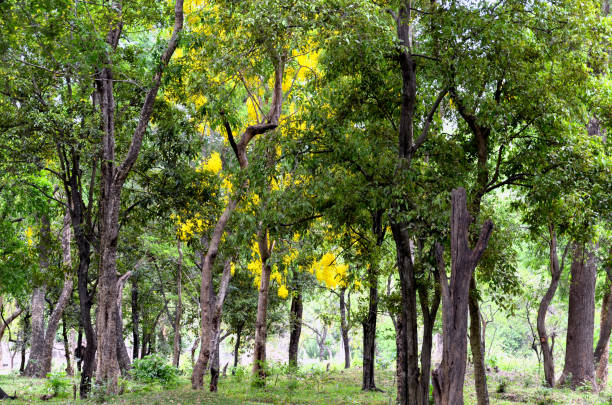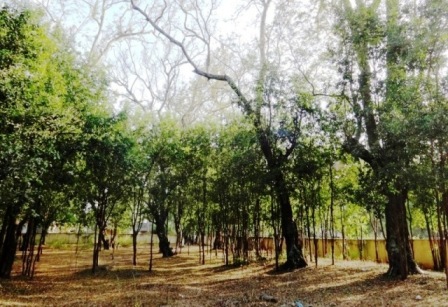Introduction
Sandalwood Sundarbans: The Sundarbans, a UNESCO World Heritage Site, is renowned for its sprawling mangrove forests, rich biodiversity, and the iconic Bengal tiger. However, many might wonder about the specific types of flora found in this unique ecosystem, particularly the presence of valuable trees like sandalwood. In this blog, we will explore whether the Sundarbans have sandalwood trees, delve into the unique plant species that define this region, and highlight how Rayal Sundarban Tourism offers an insightful experience for visitors.

Understanding the Flora of the Sundarbans
The Sundarbans, spanning the delta region of the Ganges, Brahmaputra, and Meghna rivers, is the largest tidal halophytic mangrove forest in the world. This unique ecosystem supports a variety of plant species adapted to its saline and waterlogged conditions. The flora of the Sundarbans is characterized by a mix of true mangrove species and mangrove associates.

Key Mangrove Species
- Sundari Trees (Heritiera fomes): The Sundari tree, from which the Sundarbans get its name, is the most dominant species in the region. Known for its high-quality timber, the Sundari tree is crucial for the local economy and ecosystem stability.
- Gewa (Excoecaria agallocha): Another prevalent species, the Gewa tree, is valued for its wood and medicinal properties. However, it also contains toxic sap, earning it the nickname “blind-your-eye mangrove.”
- Goran (Ceriops decandra): The Goran tree is widespread in the Sundarbans and plays a significant role in maintaining the structure of the mangrove forest with its dense root systems.
- Nipa Palm (Nypa fruticans): The Nipa palm is often found along the banks of tidal creeks and rivers. Its leaves are used for thatching and other traditional purposes by local communities.
Sandalwood Trees: A Different Habitat
Sandalwood trees (Santalum album), known for their fragrant heartwood and oil, are native to the Indian subcontinent but are not typically found in mangrove ecosystems like the Sundarbans. Sandalwood prefers well-drained soils in dry to moderately moist climates, which is quite different from the saline, waterlogged conditions of the Sundarbans.
Ecological Requirements of Sandalwood
Sandalwood trees thrive in areas with:
- Well-Drained Soils: Sandalwood requires soils that do not retain excessive moisture. The heavy clayey and waterlogged soils of the Sundarbans are unsuitable for sandalwood growth.
- Dry to Moderately Moist Climates: These trees grow best in regions with a distinct dry season, which contrasts sharply with the humid and tidal environment of the Sundarbans.
- Moderate Altitude: Sandalwood trees are often found in upland areas rather than the low-lying coastal plains that define the Sundarbans.

The Unique Flora of the Sundarbans
While sandalwood trees are absent from the Sundarbans, this region boasts an extraordinary array of plant species specially adapted to its unique environmental conditions.
Adaptive Features of Sundarbans Flora
- Pneumatophores: Many mangrove species in the Sundarbans develop aerial roots, or pneumatophores, which stick out of the soil and water to facilitate gas exchange in the oxygen-poor substrate.
- Salt Excretion: Some mangrove plants have specialized glands to excrete excess salt, enabling them to survive in saline conditions.
- Vivipary: Certain mangrove species exhibit vivipary, where seeds germinate while still attached to the parent plant. This adaptation ensures that seedlings can establish quickly in the unstable and shifting soils of the intertidal zone.
Royal Sundarban Tourism: Exploring the Mangrove Wonderland
Royal Sundarban Tourism provides an exceptional opportunity to explore the Sundarbans and its unique flora. Their eco-friendly tours offer an immersive experience that educates visitors about the ecological importance of mangrove forests and the conservation efforts in place to protect this delicate ecosystem.

Eco-Friendly Tours
- Guided Boat Safaris: Navigate the intricate waterways of the Sundarbans on a guided boat safari. These tours are designed to minimize environmental impact while maximizing wildlife viewing opportunities. Expert guides provide insights into the various plant and animal species that inhabit the mangrove forest.
- Mangrove Walks: Experience the mangrove forest up close with guided walks. Learn about the different plant species, their adaptive strategies, and the ecological roles they play. These walks are not only educational but also offer a chance to appreciate the beauty and complexity of the mangrove ecosystem. More insights can be found under “Sandalwood Sundarbans” in this blog.
Read More:
Community Engagement
Royal Sundarban Tourism is committed to involving local communities in tourism activities, ensuring that they benefit economically while promoting conservation.
- Homestays: Stay with local families in traditional homestays. This offers visitors an authentic cultural experience and provides direct economic support to the host communities. Interacting with local people also gives visitors a deeper understanding of their way of life and their relationship with the forest.
- Cultural Performances: Enjoy traditional music and dance performances by local artists. These performances highlight the rich cultural heritage of the Sundarbans and provide an engaging way to learn about the region’s folklore and traditions.

Conservation Initiatives
Royal Sundarban Tourism supports various conservation initiatives aimed at preserving the unique biodiversity of the Sundarbans.
- Wildlife Monitoring: Participate in wildlife monitoring activities, such as bird watching and tiger tracking. These activities generate valuable data for conservationists and raise awareness about the importance of protecting endangered species.
- Mangrove Restoration Projects: Get involved in mangrove restoration projects. These initiatives involve planting new mangroves and protecting existing ones. Visitors can learn about the critical role mangroves play in coastal protection and carbon sequestration. Explore the “Sandalwood Sundarbans” section in this blog for more information.
Conclusion
The Sundarbans, with their vast mangrove forests and rich biodiversity, do not have sandalwood trees due to the significant differences in their ecological requirements. However, the unique flora of the Sundarbans, adapted to its saline and waterlogged conditions, offers a fascinating study of plant resilience and ecological diversity.
We have a genuine registered company Organization: Royal Sundarban Tourism
Organisations Web link: https://royalsundarbantourism.com/
Contact: +91 7439965413 / +91 8584838109
Gpay / Phone pay : 9804049535
Email: info@royalsundarbantourism.com
Address: Village: Tiger More, Gosaba, Pakhiralay, Pakhiralay Main road, District- 24 Parganas South, West Bengal 743370

Royal Sundarban Tourism provides a sustainable and immersive way to explore this natural wonder. Through eco-friendly tours, community engagement, and active conservation efforts, Rayal Sundarban Tourism ensures that visitors gain a deep appreciation for the Sundarbans while contributing to their preservation. To learn more, see the section titled “Sandalwood Sundarbans” in this blog. Also, you can Book the Sundarban Tour At Maity Tourism and Sundarban Leisure Tourism Powered By Argusdna,
As you navigate the waterways, walk through the mangroves, and engage with local communities, you will discover the true essence of the Sundarbans—a place where nature and culture intertwine, and where every plant and animal has a story to tell. The absence of sandalwood trees does not diminish the Sundarbans’ allure; instead, it underscores the region’s unique ecological niche and the importance of preserving this irreplaceable ecosystem for future generations. You can explore additional details about “Sandalwood Sundarbans” in this blog.

